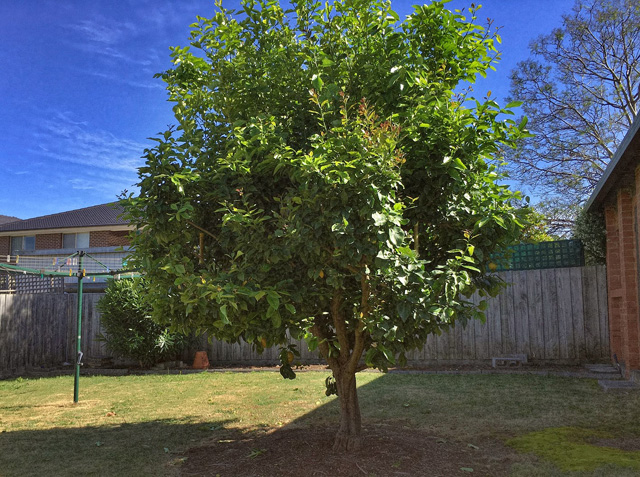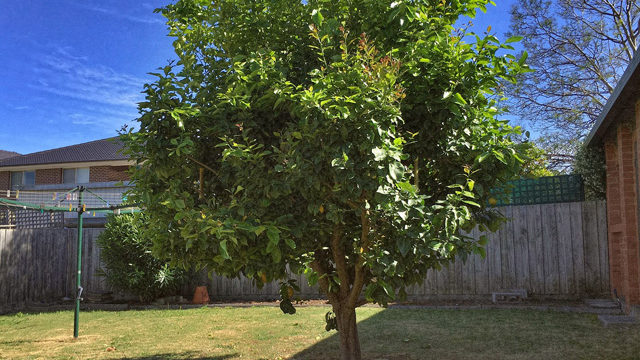
Preface
This is my fifth article submitted for publishing as a member of the Young Writers Program organised by Press Services International. This program helps to provide a ready-source of content for the magazine publication Christian Today Australia. You can read that article here.
The version that you read here is an extended version of the original article. Whereas a 900-word limit applies to article submissions, this version has no word count limitation so some of the ideas will be more fully explored here.
Introduction
In my backyard stands a lemon tree. It was planted by my parents when they moved into our family home, shortly before I was born. It is therefore, sometimes jokingly referred to as my older brother! Over the years the tree has grown from sapling into the majestic soaring fruit-bearer it is today, some 35+ years later.
The early years
At “birth” or planting, the backyard was a teeming different environment. Gum trees lined the back along the boundary fence, and two middle-aged silver birch trees dominated the remainder of the backyard. Some smaller shrubs and bushes grew along the back wall of the house and in the far corner of the property. Into this Australian backyard bush-scape entered a foreign lemon tree planting.
The first tree casualties to leave the backyard were the largest – the two gumtrees at the back. In those days (the 1980s) friends were enlisted to help slowly cut off the branches and then chainsaw the main trunk off, segment by segment. I recall as a small child watching this process from inside the house – naturally being a small child prevented me from participating let alone being allowed to watch up close this process of tree removal. At the end of the removal, the final legacy and reminder of the gumtrees in the backyard were the tree stumps (and of course the hidden roots). Removing the tree stumps would take several months if not over a year. My Dad started the process himself – grabbing the axe and hacking into the stump bit by bit to chip off a wedge from the main stump. As a learning exercise, I was taught and then slowly permitted to wield the axe. Chopping wood is a laborious exercise. From the endurance and perseverance, there came one Spring day when the trunk was no more! The final base and roots could be easily pulled out and like that – a once towering gumtree was fully removed from the landscape.
King of the Garden
Over the childhood and teenage years of the lemon tree slowly became more and more the focal point and today remains the supreme tree lording over the entire backyard. Other than one bush in the corner, the lemon tree stands tall and unencumbered by other foliage. The gum trees and silver birch trees all are no more. Even the roots of those plants were removed along with the filling in of the holes where they once stood. Instead the garden stands bare in homage to the lemon tree.
This lemon tree has acquired legendary status within the extended family circles such that overseas and interstate visitors will all look forward to visiting our home for the lemon tree. Group photos often use the lemon tree as a backdrop and my cousins who have regularly visited over the years now bring their young kids to meet the tree. The lemon tree has also been a tremendous blessing to the household, supplying 1000s of lemons over its life so far. For a season, the gathered lemon bounty was added to our neighbour’s lemon sourcing for their local chicken bar business. Over the years, many parties have been blessed with a provision of lemons in the form of lemonade and many guests have also walked away with fresh lemons.
Pruning & Maintenance
Like us humans who need regular health checks, so too does our lemon tree. In the formative years when the tree was more human height friendly, it needed more protection from myself and my young friends. Indeed, there was one incident where I somehow had impacted the main trunk and scarred it. Such was the treasured status of the tree that the discipline I received was meted out for the crime of harming a sibling! Back then I recall I could fit my hand around the core trunk of the lemon tree. Nowadays, and for the last decade or so, one person’s hands are not enough to circumference the core trunk!
Cancer has been a blight on the tree, and unfortunately there has been no full remission. Cancer to lemon trees is common in Australia in the form of gall wasps. The solution to addressing gall wasps involves pruning and removing affected branches that exhibit the galls or calluses. These unslightly bumps are formed in response to the presence of the feeding larvae. One season saw us aggressively prune back all impacted branches which saw our fruitless tree rejuvenate and return to health. Whilst that action has ensured a continuing supply of lemons, regular maintenance of the gall wasp traps is required and full treatment of our neighbour’s fruit tress helps to ensure protection.
Regularly annual pruning and fruit collection is important. From a practical perspective, the upper branches, should they bear fruit, become unreachable. When the tree is full of ripe yellow lemons, if you leave them on, the tree has to keep supporting them. Instead, if you pluck them, you enable the tree to focus on the younger growing lemons; the next generation. This lesson was not known to my Dad or myself in the earlier years and we only plucked lemons as needed in the earlier years. Old season fruits remained on the tree and the overall seasonal harvest did have reduced quantities of fruit. After learning this lesson, within two years the lemon tree was bearing a much larger harvest.
Life is Like a Lemon Tree
Throughout this narrative, you can no doubt see some of the parallels of our own lives through the lemon tree life-cycle. Just as God is our heavenly gardener, watering and pruning us, the environment in which we grow is important. The art of pruning is essential to our long-term health because over time, we all branch out into many different directions metaphorically as well as literally/physically. However, the direction we should aim to head in is God’s narrow path. In order to remain on the right track, God will prune and refine our hearts and minds. One of the biggest challenges for each of us is to maintain a God-centred attitude which is humble, selfless, kind, gentle and in essence, based on a Godly love.
Weeds and distractions should be removed to give us the space to flourish. When we get sick and need nursing, we need to recognise and act accordingly to receive healing. The weeds in our lives can take many forms and sometimes deceptively so. For example, if you surround yourself with well-meaning friends who are not pursuing God or who have a more worldly perspective, their influence on your life may lead you away from God’s garden. Having that ability to recognise them for who and what they represent is the first step in order to prune your life. Of course, we should not isolate ourselves from the world and friends outside of the community of faith. Instead, we should work to find the balance where we can introduce them to God and the faith so that we can be a positive influence on them.
Just as kids grow up, each successive generation should have their time in the sun, to play, grow and contribute. Like the lemons from a previous season, the older generations should be mindful of when God calls and anoints the next Joshua generation to take over from the Moses generation who initially led the Israelites out of Egypt.
When Life Gives You Lemons
Lemons are invariably associated with bitter and undesirable things because of their natural taste and the sensation caused to the taste buds. The sectional title “when life gives you lemons” is part of the saying:
When life gives you lemons, make lemonade.
Life will always be full of “lemons”, the not so nice aspects of life. However, our attitude and resulting action will ultimately determine how we deal with life’s adversities. Whilst we will want to reduce and minimise the encountering of lemons in life, they are ultimately unavoidable and much energy and resource will be wasted on avoidance. Instead, if we embrace the reality that lemons will come our way, we will equip ourselves to facing the lemons and ultimately transforming the initial adversity into something positive – as represented in the form of the lemonade product.
Who knows? Could it be that the tree of knowledge of good and evil from the garden of Eden was… a lemon tree?


You must be logged in to post a comment.